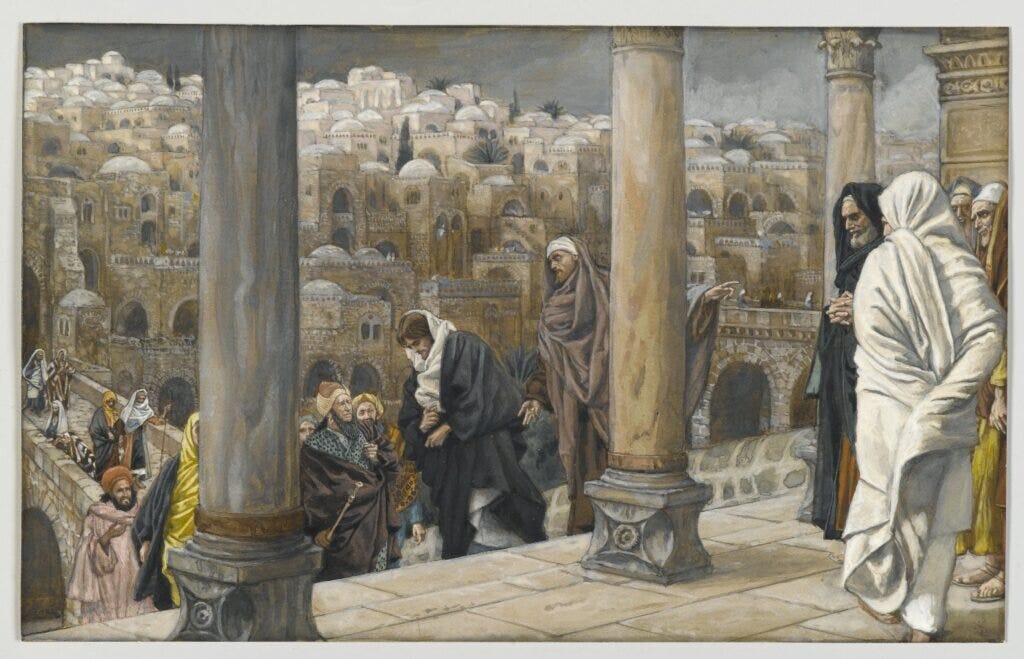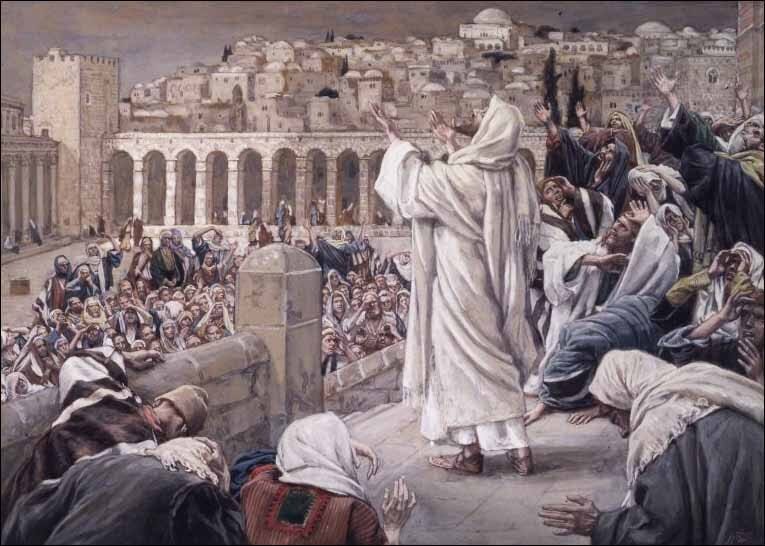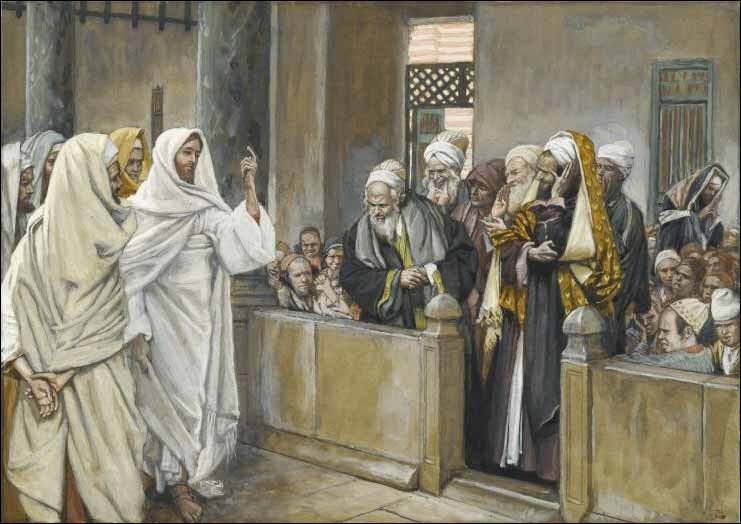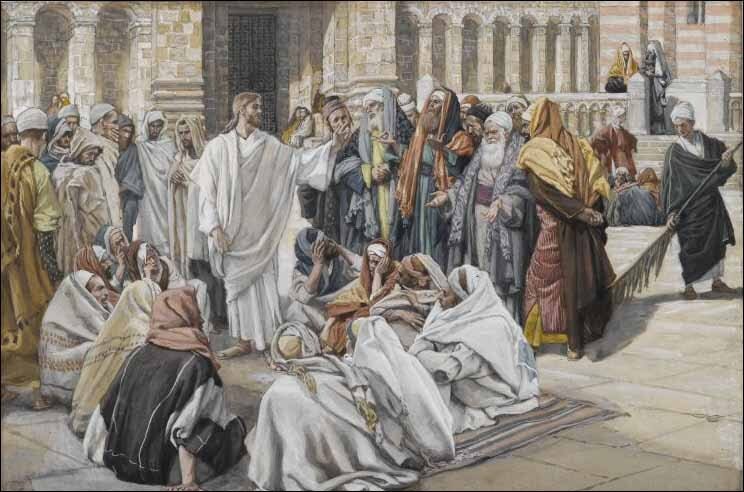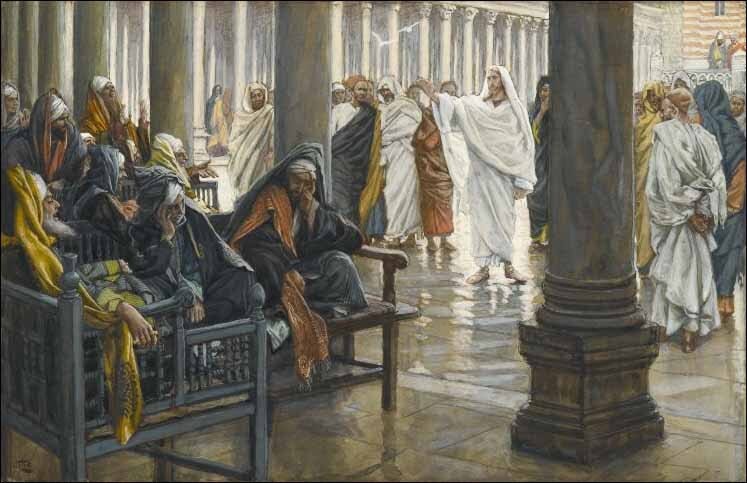Holy Tuesday, Fig Tuesday, or Great and Holy Tuesday, Illustrated with Scriptures and Commentary
By James Tissot and Dom Guéranger
This is one of a series of posts with illustrations of many of the events of Holy Week with scriptures and commentary by French painter James Tissot and with additional commentary by Dom Prosper Guéranger.
On this page:
+ The Gentiles ask to See Jesus
+ The Voice from on High
+ Chief Priests: By What Authority...?
+ The Cornerstone
+ The Tribute Money
+ The Pharisees Question Jesus
+ Woe to You, Scribes and Pharisees
From Dom Guéranger's The Liturgical Year.
To-day, again, our Saviour sets out in the morning for Jerusalem. His intention is to repair to the temple, and continue His yesterday’s teachings. It is evident that His mission on earth is fast drawing to its close. He says to His disciples: ‘You know that after two days shall be the Pasch, and the Son of Man shall be delivered up to be crucified.’[1]
“On the road from Bethania to Jerusalem, the disciples are surprised at seeing the fig-tree, which their divine Master had yesterday cursed, now dead. Addressing himself to Jesus, Peter says: ‘Rabbi, behold, the fig-tree, which Thou didst curse, is withered away.’ In order to teach us that the whole of material nature is subservient to the spiritual element when this last is united to God by faith, Jesus replies: ‘Have the faith of God. Amen I say to you, that whosoever shall say to this mountain: Be thou removed and cast into the sea! and shall not stagger in his heart, but believe that whatsoever he saith shall be done, it shall be done unto him.’
“Having entered the city, Jesus directs His steps towards the temple. No sooner has He entered, than the chief priests, the scribes, and the ancients of the people, accost Him with these words: ‘By what authority dost Thou these things? and who has given Thee this authority, that Thou shouldst do these things?’ We shall find our Lord’s answer given in the Gospel. Our object is to mention the leading events of the last days of our Redeemer on earth; the holy volume will supply the details.
“As on the two preceding days, Jesus leaves the city towards evening: He passes over Mount Olivet, and returns to Bethania, where He finds His blessed Mother and His devoted friends.”
The Gentiles ask to See Jesus
John 12:20-26: "Now there were some Greeks among those who went up to worship at the Feast. They came to Philip, who was from Bethsaida in Galilee, with a request. 'Sir,' they said, 'we would like to see Jesus.' Philip went to tell Andrew; Andrew and Philip in turn told Jesus. Jesus replied, 'The hour has come for the Son of Man to be glorified. I tell you the truth, unless a kernel of wheat falls to the ground and dies, it remains only a single seed. But if it dies, it produces many seeds. The man who loves his life will lose it, while the man who hates his life in this world will keep it for eternal life. Whoever serves me must follow me; and where I am, my servant also will be. My Father will honor the one who serves me.'"
The Voice from on High
John 12:27-33: "Now my heart is troubled, and what shall I say? 'Father, save me from this hour?' No, it was for this very reason I came to this hour. 'Father, glorify your name!' Then a voice came from heaven, 'I have glorified it, and will glorify it again.'
"The crowd that was there and heard it said it had thundered; others said an angel had spoken to him.
“Jesus said, 'This voice was for your benefit, not mine. Now is the time for judgment on this world; now the prince of this world will be driven out. But I, when I am lifted up from the earth, will draw all men to myself.' He said this to show the kind of death he was going to die."
Chief Priests: By what authority...?
Mark 11:27-33: "They arrived again in Jerusalem, and while Jesus was walking in the temple courts, the chief priests, the teachers of the law and the elders came to him. 'By what authority are you doing these things?' they asked. 'And who gave you authority to do this?'"Jesus replied, 'I will ask you one question. Answer me, and I will tell you by what authority I am doing these things. John's baptism--was it from heaven, or from men? Tell me!'
"They discussed it among themselves and said, 'If we say, "From heaven," he will ask, "Then why didn't you believe him?"But if we say, "From men"....' (They feared the people, for everyone held that John really was a prophet.)
"So they answered Jesus, 'We don't know.'
"Jesus said, 'Neither will I tell you by what authority I am doing these things.'"
The Cornerstone
Matthew 21:42-46: "Jesus said to them, 'Have you never read in the Scriptures: “The stone the builders rejected has become the capstone [or cornerstone]; the Lord has done this, and it is marvelous in our eyes?" Therefore I tell you that the kingdom of God will be taken away from you and given to a people who will produce its fruit. He who falls on this stone will be broken to pieces, but he on whom it falls will be crushed.'
"When the chief priests and the Pharisees heard Jesus' parables, they knew he was talking about them. They looked for a way to arrest him, but they were afraid of the crowd because the people held that he was a prophet."
The Tribute Money
Matthew 22:15-22: "Then the Pharisees went out and laid plans to trap him in his words. They sent their disciples to him along with the Herodians. 'Teacher,' they said, 'we know you are a man of integrity and that you teach the way of God in accordance with the truth. You aren't swayed by men, because you pay no attention to who they are. Tell us then, what is your opinion? Is it right to pay taxes to Caesar or not?'
"But Jesus, knowing their evil intent, said, 'You hypocrites, why are you trying to trap me? Show me the coin used for paying the tax.' They brought him a denarius, and he asked them, 'Whose portrait is this? And whose inscription?'
"'Caesar's,' they replied.’
"Then he said to them, 'Give to Caesar what is Caesar's, and to God what is God's.'
"When they heard this, they were amazed. So they left him and went away."
The Pharisees Question Jesus
Mark 12:28-34: "One of the teachers of the law came and heard them debating. Noticing that Jesus had given them a good answer, he asked him, 'Of all the commandments, which is the most important?'
"'The most important one,' answered Jesus, 'is this:’
"‘Hear, O Israel, the Lord our God, the Lord is one. Love the Lord your God with all your heart and with all your soul and with all your mind and with all your strength.’
"'The second is this: "Love your neighbor as yourself."
"'There is no commandment greater than these.'
"'Well said, teacher,' the man replied. 'You are right in saying that God is one and there is no other but him. To love him with all your heart, with all your understanding and with all your strength, and to love your neighbor as yourself is more important than all burnt offerings and sacrifices.'
"When Jesus saw that he had answered wisely, he said to him, 'You are not far from the kingdom of God.' And from then on no one dared ask him any more questions."
Woe to You, Scribes and Pharisees
Matthew 23:13, 23-26: "'Woe to you, teachers of the law and Pharisees, you hypocrites! You shut the kingdom of heaven in men's faces. You yourselves do not enter, nor will you let those enter who are trying to.....’
"'Woe to you, teachers of the law and Pharisees, you hypocrites! You give a tenth of your spices—mint, dill and cumin. But you have neglected the more important matters of the law--justice, mercy and faithfulness. You should have practiced the latter, without neglecting the former. You blind guides! You strain out a gnat but swallow a camel.’
“‘Woe to you, teachers of the law and Pharisees, you hypocrites! You clean the outside of the cup and dish, but inside they are full of greed and self-indulgence. Blind Pharisee! First clean the inside of the cup and dish, and then the outside also will be clean.'"
Previous:
Next:
Overview:
After his conversion back to the faith of his childhood, James Jacques Tissot, famous and wealthy French realist painter of worldly scenes, took three arduous trips to the Holy Land to seek out and record authentic details about the people, the landscape, the architecture, and the way of life. On his return he created a series of goache (opaque watercolor) illustrations of the life of Christ.
In 1896, the illustrations went on a trans-Atlantic tour to be displayed in London, New York, Boston, Philadelphia and Chicago, and they attracted throngs, many of whom were moved to intense devotion wherever the illustrations were shown. In 1900, the illustrations along with Tissot's preliminary drawings and notes were purchased from the artist on the advice of John Singer Sargent to be the centerpiece collection of the newly formed Brooklyn Museum of Art—with the help of thousands of subscriptions from average citizens.
For a more-complete introduction to the amazing unclassifiable works of the complex and unique artist James Tissot, you might want to read this article of mine at ReligionUnplugged.Com: Contrasting Visions Of Painter James Tissot, The Secular And Sometime Mystical Realist.
The images in this series are downloaded from the Brooklyn Museum. "RIGHTS STATEMENT: No known copyright restrictions."



